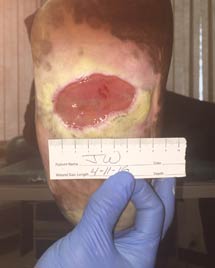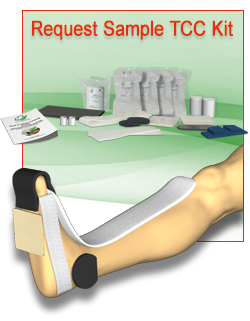 |
Dr. Michael Miller DO FACOS, FAPWCA, WCC |
Okay fans, let's talk about the science behind Total Contact Casting. But before we talk about the science, what is a Total Contact Cast? Well, before we talk about Total Contact Casting, let's talk about the key to not just healing wounds but preventing them. But before we talk about preventing and healing them, we need to talk about them … wounds that is.
Wound is a term that usually means a defect in the epithelium, which is a five syllable word for skin. Another term you might hear is the word "ulcer". The simplest way to differentiate these two is to remember that an ulcer arises from the inside and comes out whereas a wound starts on the outside and progresses inside. The key to understanding this is by example's…
The ill equipped robber whose gun fired while he was walking into the store did not receive a gunshot ulcer, he got a gunshot wound. The bullet caused the damage from the outside, in.
The person who took too many aspirin every day and started to have terrible stomach pain did not develop a gastric wound, he developed a gastric ulcer. The lining eroded from the inside out.
The beautiful model who could not have her picture taken had a herpes ulcer of her lip, not herpes wound. This ulcer developed from the inside of her lip to the outside
The patient who had his hernia fixed and then bumped the incision causing it to open, does not have a stomach ulcer, they have a stomach wound. The incision opened up from the outside exposing the inside.
Now that we have the definitions done, back to prevention and treatment. Of course the most obvious question that you need to ask is, what is our diagnosis (diagnoses) for either why this wound developed or what is specifically keeping it from healing?
 |
DFU one week after debridement and a total contact cast |
For a diabetic neuropathic ulcer, these most commonly occur below the ankles and the reason has to do with the fact that the neuropathy (nerve damage) usually manifests as a lack of sensation, precluding the patient from reacting to problems with their feet. This could mean shoes that are too tight, shoe tongues that are bent or folded over, seams inside that are roughened, or deformities of the foot as well as going barefoot and walking on stuff that ordinarily wouldn't or shouldn't be walked on. And so the keys to healing these types of ulcers (yes I'm still talking about the diabetic neuropathic ones) is to get the pressure off the foot. Interestingly, this term is called "Offloading". And yes, this applies to pressure based tissue injuries like bedsores (decubiti, decubitus ulcers, pressure sores, etc.). Of course, any idiot knows that venous ulcers occur between the ankles and the knees usually on the inside of the leg, and that bedsores occur over bony prominences etc. and so on. But since we are on a site with a diabetic neuropathic ulcer treatment product line, then we are going to stick to talking about those…you gotta dance with the one that brought you. This neuropathy we talked about can injure the three major types of nerves in the periphery namely Sensory (feeling), Motor (movement) and Autonomic (stuff like goosebumps and heart rates, blood flow and such that are automatic and not usually under our direct control). If these get screwed up individually or together, then all heck can break loose including dry skin, loss of hair growth, cold feet, poor or loss of sensation and those weird foot deformities that look like the bottom of grandma's rocker (Charcot's Arthropathy).
Worse, all this stuff can lead to an open ulcer in those who have poor or no sensation in their feet. The test for this loss of sensation by the way is to use a small flexible fiber called a Semmes Weinstein fiber which will bend at 10gms of pressure when pushed into the bottom or top of the foot. If a patient cannot feel this when touching their skin (especially on the feet), then it is said that they have neuropathy and have lost protective sensation. This means that the ugly hole in front of you may look horrible but they can't feel it.
From there, a bit of expertise is needed. Unlike almost every other kind of ulcer or wound, these actually do need to be debrided frequently and the earliest literature suggested weekly. It is often hard to convince patients that they need their feet assaulted weekly so an every-other-week debridement is acceptable. Of course, debridement means that ALL aspects of the ulcer including the skin margins and THE ENTIRE WOUND BASE is removed until there is 100% bleeding. Anything less is unacceptable since the key to healing Diabetic Neuropathic Ulcers is to make sure the exposed tissue is healthy and able to heal and not Senescent (old and lost it's oomph !). An important differentiation regarding how much to debride is that the debridement should result in 100% visible bleeding NOT audible bleeding.
After you have made sure that the bleeding is done (Yes, all bleeding eventually stops but exsanguination is considered BAD FORM), then it is time to apply the Total Contact Cast. I will not belabor this other than to say that the goal is to make sure the cast is evenly applied across the plantar surface (that the bottom of the foot for the non medical reader) and the cast is at least as highup as the mid calf. In other words, why do you think we put instructions in the kits if not for you to use them? Make believe your wife is not there with you applying it and ask for help if you need it for gosh sake !! Applying it correctly means that weight of walking is not solely on a single area on the bottom of the foot or worse the ulcer but rather evenly distributed across the bottom of the foot and the lower leg takes it's share as well. If not, then the ulcer worsens and you have wasted both our time as well as reducing your claim of knowing what to do for stuff like this.
Once dry, the Total Contact Casting process is essentially done assuming you didn't foget to put the pressure plate and rubber gasket on the bottom for them to have walking surface. If all you have is just fiberglass on the bottom for them to walk on, you will have fibermush there in a short time. Of course the patient needs to understand that these casts are not made of titanium nor water proof so using them to put out fires, block leaking pipes, doing skateboard tricks, dancing the beer barrel polka and the like are heartily discouraged.
The last and most important piece of information is how do you get paid for this?

The HCPCS (Never mind what these letters stand for. It's Federal and even if you knew, they are just going to change the meaning in another year) code for the cast materials used in a Total Contact Cast kit is:
Q4038 - Cast supplies, short leg cast, adult (11 years +), fiberglass
This is the ONLY code is used (regardless of how many rolls of plaster and fiberglass, who made it or what else is included in the kit) to get reimbursed for the materials you use in a Total Contact Cast.
The reimbursement for this is $40.17 per unit. That means each use of Q4038, NOT how many rolls you use.
CPT code 29445 - Application of rigid total contact leg cast is reimbursed in a facility (Hospital based wound care center) at $107.13
If you apply one in an office setting, the reimbursement for 29445 is $138.30
For those who use APC codes (Hospital Outpatient Facility), then you would have your indentured hospital lackeys charge $208.88. Remember that the hospital codes include the supplies as well as other stuff hospitals get to mix in and get paid for.
So for those of you who play by the rules and apply a Total Contact Cast, you can expect to get reimbursed approximately:
$147.30 in a facility
$178.47 in an office setting
Only $208.88 in the Hospital Outpatient Facility.
You aren't going to get rich putting on a Total Contact Cast but you are going to get paid reasonably well. More, you are providing the standard of care for offloading plantar based diabetic Neuropathic ulcers. Why do you think nobody pays for the darn crazy walkers and boots and surgical shoes? Cause they have never been shown to even come close to a Total Contact Cast. I mean, why let someone else make money at your and your patients expense in a scenario that means "SUBSTANDARD"!
If you are gonna talk that "Evidence Based" care, then gosh darn it…DO IT!!
Dr. Miller who does a ton of Total Contact Casts and really knows what I'm talking about